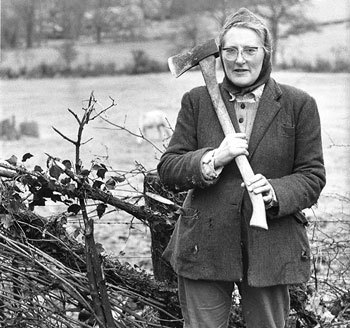#hedgelaying
Explore tagged Tumblr posts
Text
Hedges and how to lay 'em.
(weird first post, I found these photos on my phone and wanted to write something. Sorry if my formatting repulses you- I'm new around these parts, my grammar will be bad coz tired. This guide is only to spark the imagination, please consult a variety of sources before carrying out a task such as this)
Hedges. Not the planted rows Buxus or Leylandii that many in Western Europe have become accustomed to as the staple boundary, I'm talking about the old fashioned, stock boundary hedge.
Tools and equipment
PPE, including waterproof clothing and acceptable footwear.
A billhook or hatchet
A pruning saw
Welding gauntlets
First of all we need to lay some basic principles out. Angiosperm trees can heal themselves quite well in funny ways that make them grow in strange ways, case in point 👇
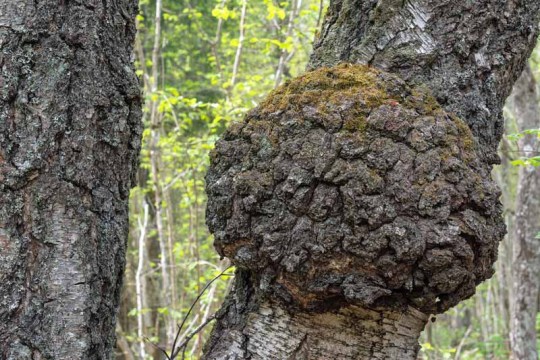
(Credit: Gardener's path)
As long as layer of various plant based plumbing, xylem and phloem, remains a it can survive an injury such as this one 👇 that I made,
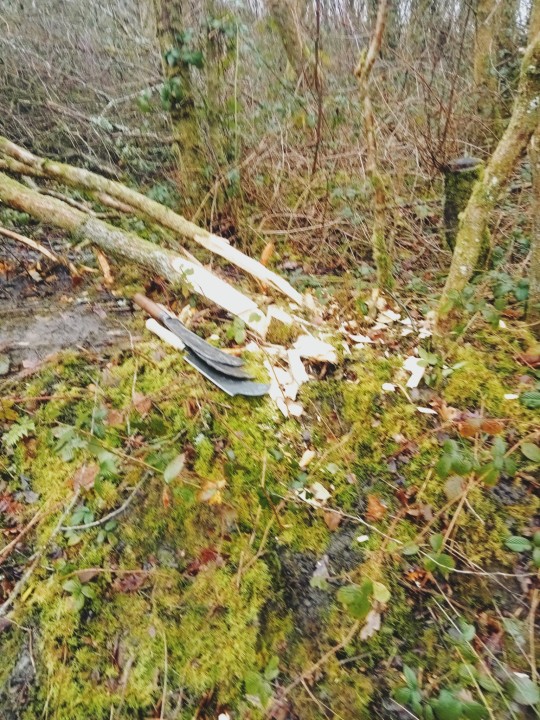
(Sorry the photo is crap, my phone camera isn't great).
Why did I do this? Am I a sick, twisted motherfucker who likes to torture trees? No. Well sometimes on a Saturday evening with consent from all parties, but this my friends is the starting move to laying a hedge. (Note, this should be done when the sap isn't flowing, my preference is January to February, but can be carried out from October to March in the northern hemisphere).
Individual trees on a bank in a row are referred to as pleachers. These require a 45 (ish) degree cut to be made three quarters of the way through the stem. It should then be bent over👇
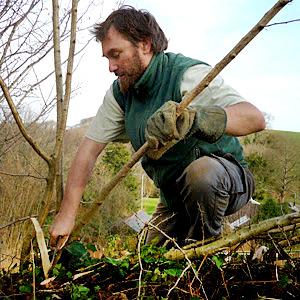
(Credit: Devon rural skills hub)
This pleacher, if not the first, can be woven into the rest, wear gloves for the love of God almighty. This is an intricate job, a neat hedge should have very little lean and brush should preferably be concentrated in gaps. Cutting the pleacher will leave a pointed wedge of wood at the base of the stem, called a spar, this can impale someone if not cut off so please do.
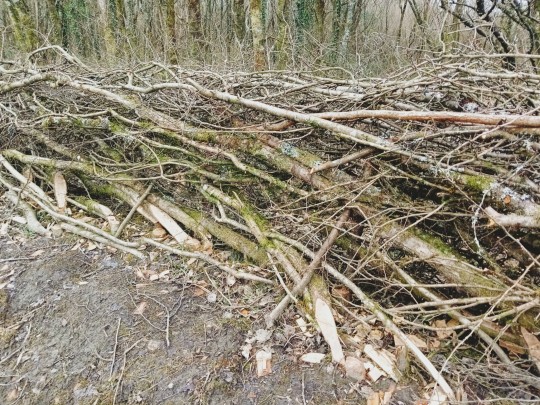

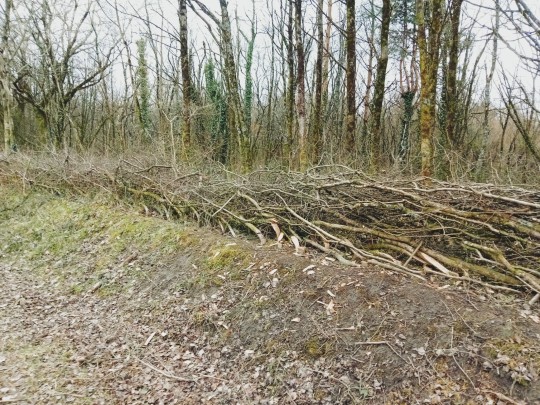
This is the completed hedge, which is laid in the Glamorgan style.
The trees that make up the hedge will grow into a thick, tall, living barrier.
Hedges must be relaid over generations, and soon enough I'll have a video detailing how to plant a hedgerow.
History
Hedgerows were invented by John Hedge and his husband Hugh Row in 1755...oh no that's my rural history fanfic. Hedges were actually invented by, well actually we don't know. I've heard it said that they've cropped up in the fertile crescent and ancient Rome. My personal theory is that they are a Neolithic or earlier invention which resulted from a failed coppicing attempt (coppicing post coming to a Tumblr blog near you) the individual who happened to do it may have discovered that the tree was still alive and thus the possibilities of tree shaping were extended to barriers.
Now, as an ancom who decries attempts to stifle the rights of the proletariat, I would be remiss in informing you of one important part of hedge history: the enclosure of the commons. Common land formerly was land for people to graze stock, pannage pigs, forage, hunt and collect firewood. The inclosure act of 1773 allowed private landowners to close common off from the commoners thus creating starvation. And it was all done with hedges, eco-friendly opression of the working class! Yaaaaay!
The importance of hedgerows.
Hang on, you may think to yourself, eco-friendly? How is savaging trees eco-friendly? Good question, dear reader. For a number of reasons;
The regrowth of trees means no loss of fruit or flowers in the long run, thus providing food resources to animals.
Shelter is provided to herps, inverts, nesting birds and small mammals through a diverse branch structure.
The general damp and dim conditions provides a safe haven for bryophytes and fungi.
The hedgebank is a bread and butter to the burrowing animal. Foxes, badgers and rabbits all frequently use hedgebank as the entrance to their dens, setts and warrens.
They act as wildlife corridors for animals to travel from habitat to habitat, thereby helping to combat habitat fragmentation.
Hedgerows in Wales have declined 50% since the second world war and the push to mechanise agriculture. 60% of our current hedgerows are in a substandard condition.
There is a human benefit too, and it isn't just the confinement of livestock.
My maternal family are South Welsh rural folk: foresters, shepherds and the like. My paternal family are Romanichal, who lived a nomadic life in former days. Both have one thing in common: life without the hedgerow that provided fruit and meat would have been a damn site much harder than what it already was.
Therefore I advocate the hedge not only to preserve wildlife but also to provide ample wild fruits (though I wouldn't recommend crab apples to eat, other trees like bullaces and medlars are excellent) and meat for the poorer rural working class, the ever increasing rural homeless population and whomever else needs it.
DISCLAIMER!!!!
I haven't covered everything here, so if you don't look up any other sources you'll probably bugger up somewhere. Please do your homework and make sure you don't injure yourself, or potentially harm nature.
#conservation#rural#rural skills#country skills#cottagecore#solarpunk#wildlife#fair shares#permaculture#livestock#don't sue me if you try this and something goes wrong please#hedgelaying#hedgerow#countryside management#countryside#gardening
6 notes
·
View notes
Text

Westcountry hedgelayer is out there living the dream. If you ever insta, I recommend following him
0 notes
Text
Hedge Laying, 5th May, 2020
Hedge laying trip
It was the Great Hedge Laying Trip last Thursday. I’d taken myself and husband Neil, cameraman, up to Richmond overnight. We had no idea where we were as we’d just followed Stephen in our car to somewhere near Bedale in North Yorkshire the next morning. Me and Stephen have known each other since we were born, our mums are childhood friends. We arrived on the edge of a farm where the hedge that they’d laid already stretched off into the distance and fighter jets were flying around from RAF Leaming, so it was quite noisy. I did have a go at this years ago but I couldn’t remember what to do, but was eager to have another go. He had told me this hedgerow was planted about 10 years ago with hedge laying in mind (the farmer he works for is a top man! I hope to meet him one day, he sounds very conscientious and a forward planner regarding conservation, I’d love to interview him and see what I can learn) so now is the time to actually lay the hedge…and all the trees are mainly Hawthorn, Blackthorn a bit of Gelder Rose, a bit of Dog Rose, Holly and Field Maple.
Stephen’s background is a degree in countryside management and conservation work. He works for conservation charities and is now self-employed doing hedge laying in the winter and working for a nature reserve. This job came about from the landowner in Well who knew he did hedge laying and needed hedge laying all over his land.
“Loads of it.” As Stephen put it “He’s passionate about his hedgerows.”
“Let’s talk about tools. What have we got?” I asked.
“There’s two types of billhooks here, there’s loads available, regional styles. This is a Yorkshire billhook, which is probably the biggest, well it is the biggest one. And that’s a Stafford Pattern. And they’re principally the tools. A pair of loppers, it makes it easier. Obviously chain saw for the bigger stuff.”
He’d bought his billhooks from the Vintage Tool Shop. The idea with a billhook is that you just cut so far through the tree, enough that it’s pliable enough to bend over without snapping, but not too much that you lose the tree. (What is a billhook?)
Photo of me using a billhook. Notice the cut, in this case, is on the right of the trunk as it will be laid down to my left. Enough of the trunk is left attached so it doesn’t snap, which needs really careful attention, otherwise the trunk is completely cut through rendering it unable to be incorporated into the hedge. The tree may not die, depending on the species, but would take years to grow to a suitable height for the hedge.
He went on to explain that billhooks are used for the laying. In years gone by, people would have used axes but nowadays they use a chainsaw to speed things up because people have to make a living out of it. Centuries ago, all the agricultural labourers would have worked together on it. Most hedges were planted, and dry stone walls, in the 1600’s mainly, because that was the main ‘Inclosure Act’ of 1773 was passed in this country, where all the land was divided up and farming methods changed. It is still in act today. “Do they have original hedgerows still growing around? Have you ever come across any really ancient ones?” I asked.
And I was really pleased as he said “Yes, I’ve laid one up in Well which was, well they don’t know exactly how old it is but it’s generations and generations, so it’s hundreds of years old.” And that “it’s been laid before obviously, and by laying a hedge, you’re promoting the length of its life because of the regrowth.”
Interested to know about what management has to be done once a hedge has been laid, as I assumed it would be just like trimming off the tops and the sides he said
“You can let it grow back up and re-lay it, or if, because it’s quite expensive to lay them, you generally let them grow up, keep trimming them and they just get denser and denser until eventually there will come a point where you will need to let it grow up and re-lay it again. The whole point of laying it is that if you don’t lay them, this is a newly planted hedge about 10, 12 years ago, if you don’t lay them and just keep trimming them, they just get gappy at the bottom. And the whole idea is that it’s stockproof. And if it’s all gappy at the bottom livestock can get underneath it.”
So what livestock, sheep, or just any?
“Sheep, cows. You’ve got various regional styles of hedge laying depending on what stock you have. This is laid in a Yorkshire style, but it’s actually staked in a Lancashire style (laughing) the purists wouldn’t like it, but originally the Yorkshire style would have had stakes down the middle with a top rail fastened on because it’s laid so low, it’s laid much lower than other hedges. Most people think of the Midland Bullock Hedge which is more at 45 degree angle and it’s got the woven hazel on the top as binders, whereas the Yorkshire one just had a rail on. Each region developed different styles depending on what they had. In Yorkshire it was uplands, so there was coppices, no abundance of hazel and stuff to coppice, to weave for binding, so they used to put a rail on, just so it was stock proof for the first season.”
He said it’s just nailed on top of the posts and it doesn’t look very pretty, but it’s not necessary on his hedges, so there’s no point doing it. If you were in a competition you would have to do it because that’s the style but his hedge doesn’t need it because it’s fenced in and next to an arable field, so it doesn’t need to be stock proofed.
Once this hedge has been laid, it will just keep growing forever as long as somebody manages it. They’ll let it grow up to the height they want and then they’ll keep trimming it and it will just get denser and denser and then eventually, probably in 20 years maybe, maybe longer, they’ll let it grow up a bit more and then they’ll re-lay it again.
The thorns of the blackthorn are lethal, I’ve had them in me a few times. They’ve got some bacteria that lives on it’s tips, so when you get the blackthorn in you, it hurts, it swells, and some people get infection from it. So gloves! Always wear your gloves!
Then it was time for me watch Stephen demonstrate how to do it and then for me to have a go. For my first attempt, I was chipping away, using far too many cuts to lay one, which amused the onlookers and Stephen said try not to put my billhook in the soil which made us all laugh! Then I got stuck on the fence so Stephen had to free me. For my next attempt I made 1 cut to the next tree which was sufficient enough to lay it, getting my street cred back!
Everyone joined in laying some hedge and Stephen was preparing the trees for laying with the chain saw, to which my husband said ‘There’s no stopping him now, he’s off, it’s what he was like driving this morning when we were to keep up!
Bob, who has worked with Stephen for years had joined us at this point. He said “It’s fantastic how it comes again, isn’t it?”
Hedges are laid uphill so the sap can rise. If you lay a tree downhill you’ve got to bend the trunk more so there’s more danger of snapping it. Essentially, it’s like coppicing as the regrowth comes from the base of each stem or the tree trunk, (some regions call hedge laying ‘Pleaching’) and you get regrowth along the stems as well. These are all living because you’ve preserved enough sapwood and bark so they will regrow, but eventually the trunk you have laid will die, but by the time they’ve died, you’ve got all the regrowth from the base.
My gloves were too big, and kept falling off. I spent time pushing down the branches to keep the laid hedge low and yes, I got black-thorned straight through my glove, straight into my knuckle, but I laughed it off as it is all part of the process!
All in all, we had a fantastic day which I will always remember, thank you Stephen! Photo - ‘I’ve been black-thorned! It really hurts!’
0 notes
Text

One of life's little pleasures
0 notes
Text
having a countryfile watch party tonight because my granddad is on it :)
4 notes
·
View notes
Text
The National Hedgelaying Society is the only charity dedicated to maintaining the traditional skills of hedgelaying and encouraging the sympathetic management of hedgerows for wildlife and landscape. We have no paid staff and rely entirely on members subscriptions and the generosity of sponsors.
Hedgelaying is a country craft which has been practised for hundreds of years. The correct management of our hedgerows is essential if we are to conserve our wildlife and landscape for future generations.

The correct management of hedgerows is therefore vital if they are to survive and be healthy enough to provide a good habitat. Over-management by hard trimming to the same height each year will ultimately degrade the hedge so it is hollow at the base and provide little shelter for wildlife. At the other extreme neglecting a hedge will allow it to become tall and overgrown, eventually even to collapse.
Sympathetic management allows blossom and berries to form, allows the hedge to slowly and incrementally increase in size and keeps the hedge in a healthy condition. Eventually though every hedge needs to be rejuvenated from the base and hedgelaying is one of the best and most traditional ways of doing this. A laid hedge provides a stock proof barrier and a dense habitat for wildlife but most importantly it encourages new growth that starts a new life cycle of the hedge.
Hedgelaying preserves the past and protects the future.
1 note
·
View note
Text
#aFactADay2022
#501: hedgelaying (or pleaching) is the process of basically laying a vertical hedgerow on its side so that it grows new shoots. the stem ("pleach") of the hedge is cut on one side but a thickness of sapwood is left to keep the pleach and leaves alive. the top part of the pleach is basically pushed over by between 30 and 90 degrees so the entire hedge is laying on its side. new shoots go up from the incision point and grow new branches. this means the hedge keeps as thick and tangled as possible, without growing too tall and leggy. this was initially a practice for keeping hedges thick enough for sheep to not fit through ("stockproof").
within the UK alone there are 12 different local variations, where the angle, incision depth, period of the support stakes, and repetitions are varied. for example, the yorkshire style is characterised by a denser base (more stems; more regular pleaching) and stakes with a nailed rail on top, while a modern "motorway style" hedge often doesnt have stakes at all and is performed less regularly because it has less of a need to be stockproof. my favourite is the cornish style - hedges are placed either side of a lane or ditch and are raised on banks of dirt and faced with stones. sometimes there isnt even a shrub on top of the bank, but its still technically a hedge.
the isle of wight style is apparently now almost extinct, but was an efficient way to get a stockproof barrier up quickly and easily, although it is untidy. it is pleached very widely and stakes are placed at irregular intervals but alternate either side of the hedge, very differing to the yorkshire style. in the brecon style, the stakes are placed in the middle. its what is known as a "double brush style" because the twiggy ends of the pleachers are kept on both sides of the hedge.
now youre a hedgelaying expert!
0 notes
Text
Charles III! The Slightly Creepy King Who Talks To Trees and Spent His Life Waiting.
— By Imogen West-Knights | May 05, 2023 | Assessment

A facsimile of King Charles III on Friday in London. Finnbarr Webster/Getty Images
People have been wondering what a Charles III reign will look like for a long time. They’ve had a lot of time to do it: He’s the longest-serving heir in British history, having spent 70 of his 74 years next in line to the throne.
It has been unclear what Charles ought to be doing with his time on earth. His job has been, more than anything else, to wait, and to wait for something both monumental—becoming a king—and ghoulish—the death of his mother. The pitfalls of not quite finding your place in the world as a member of the royal family and kicking your heels on top of a near-limitless mountain of wealth are very clear: You get a Prince Andrew situation.
So how has Charles been passing the time? In the mid-’70s, when he was approaching 30, he began setting up charities, and he kept at it: He held a summit in 2009 with the intention of protecting the climate and reducing deforestation that saw Hillary Clinton and U.N. Secretary-General Ban Ki-moon in attendance. He’s a keen agriculturalist, and believes that industrial farming is an environmental travesty. He has his own organic farm in Gloucestershire, where he keeps up traditional farming techniques, and where he hosted the “National Hedgelaying Championships” in 2005. He’s also spent much of the past couple of decades getting involved in politics through what became known as his “black spider memos,” after his scrawling handwriting: letters he would write to government ministers on subjects like urban planning and education. He’s been vocally in favor of overhauling the “honours system,” whereby titles such as “Commander of the British Empire” are handed out to the rich and powerful, a designation he has said is bestowed on “the wrong people” for “the wrong reasons.” He’s subsequently been accused of interfering in political matters to an undue degree. A critically acclaimed play called Charles III premiered in London in 2014 and went on to Broadway. It depicted Charles meddling with freedom-of-the-press laws, sparring with Parliament, and ultimately having to abdicate in favor of Prince William. A more sympathetic portrait came on the TV series The Crown, on which he was recently played by Dominic West, but even there, he was most memorably portrayed as an ambitious but ineffective royal conniver.
There’s also the slightly woo-woo stuff—a hippie-ish bent. In 2010, he gave a now-famous interview to one of the U.K.’s foremost celebrity gardeners (yes, we have several of these), Alan Titchmarsh, in which he said he talks to the trees on his estate, something he asserted keeps him “relatively sane.” It’s not accidental that the official invitations to the coronation featured an illustration of the Green Man, a sort of pagan vegetation spirit associated with ancient English folklore (although it’s not actually as ancient as many people think). He co-authored a book on his beliefs about the environment and the “magical” rhythms of nature in 2010, too, called Harmony: A New Way of Looking at Our World.
“Charles Won’t Be Allowed To Express His Opinions On Things Anymore, But In Some Ways That Doesn’t Matter. It’s Too Late.”
But the truth about Charles is that he is a traditionalist, really. He famously hates modern architecture, and seems to long for a return to a romantic idea of a pre-industrialized England, of farmhands working the land and feeling a deep connection with their local and national community.
What’s he like personally? We know the ins and outs of his rocky marriage to Diana and their subsequent divorce all too well. His current wife and now Queen Consort, Camilla, admits that he can be obstinate, describing him as “pretty impatient.” “He wants things done by yesterday,” she has said. “That’s how he gets things done.” It is also undeniable that he is a little bit creepy, perhaps just by virtue of being necessarily so out of touch with normal life, coming out with statements like “Mummy laughs and cries with us all,” about the late queen, which sounds like something a haunted doll would say before its head spins all the way around.
The thing about becoming king is that the role of a monarch is strictly defined in the U.K. They must act with political neutrality. In other words, there will be no room for black-spider memos, none for backhanded comments about political machinations in the country he reigns over; no room, ideally, for personal opinion at all. He knows this well. In 2018, Charles gave a television interview to mark his 70th birthday, promising he would not be a “meddling” king. When he was asked whether his campaigning on various issues would continue, he put it bluntly: “No, it won’t. I’m not that stupid. I do realize that it is a separate exercise being sovereign.”
But that doesn’t mean his reign is going to feel much like his mother’s. Charles is, by default really, the most modern king the U.K. will have had. He’ll be the first monarch to have been to school. He’ll be the first monarch whose life has been subject to tabloid scrutiny, whose failures and foibles are already well known to the public before he ascends the throne. Elizabeth II had an appeal that extended beyond people who would consider themselves royalists—she was a fixture in national life, thought of by many as a sort of benign grandmotherly figure and, based on the very little information people ever got about her, quite widely liked in the U.K., as monarchs go. She intentionally kept her private self hidden. Unlike Charles, she almost never gave a televised interview, and although she agreed to let a BBC crew chart the lives of the royal family in 1968, she reportedly felt when the subsequent documentary came out that it had opened too wide a window on the inner lives of the royals. She is said to have personally had it scrubbed nearly out of existence, other than in a few physical archive locations. By contrast, if you want to, it’s all too easy to find out perhaps too much about the king’s intimate personal history via, for example, Googling the words “Prince Charles” and “tampon” together.
Charles won’t be allowed to express his opinions on things anymore, but in some ways that doesn’t matter. It’s too late. We already know them. And his conduct before taking the throne will probably dictate his popularity during his reign more than anything else. Opinion polls have consistently shown him to be less popular than Queen Elizabeth II, or his son Prince William. Anti-monarchist protests are now a fixture at his public events. He’s been egged. Charles III may be a more modern monarch than his mother was, but he will be ruling over a very different country than the one she looked out on at her coronation in 1953—and the judgment of his reign has been underway for most of his lifetime.
— Slate.Com
1 note
·
View note
Text

Actually I’m not just letting this drop, as I’ve realized that most people probably have no idea what I’m talking about. A billhook, or bill hook, is a tool used primarily in hedgelaying. Its typical form has a hook on one side and a blade comparable to a hatchet on the other. Some of them have a bit of a spike at the end. These things are intended for cutting and otherwise manipulating shrubs and small trees. I use mine to fight the ongoing war against the blackberries. And they can be mounted on whatever length handle you need, so for maintaining deeper, denser hedges you’ll see this kind of blade on the end of a pole like a broom handle or longer. Does that remind you of something?

Yep, there it is. The billhook is the peasants’ halberd.
And that’s all the essay you’re going to get.
Why are pitchforks the go-to symbol of mob justice and not scythes? I would imagine a scythe would be a much more effective weapon if all you have at your disposal are peasant farm tools.
81 notes
·
View notes
Text



7 notes
·
View notes
Text
instagram
I don't care much for instagram but this one is worth it
#uk#winter#autumn#spring#countryside#craftwork#hedgelaying#hedgerow#craftsmanship#england#quantocks#somerset#Instagram
1 note
·
View note
Photo
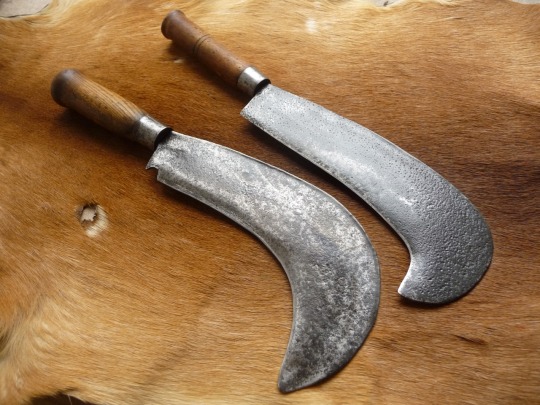

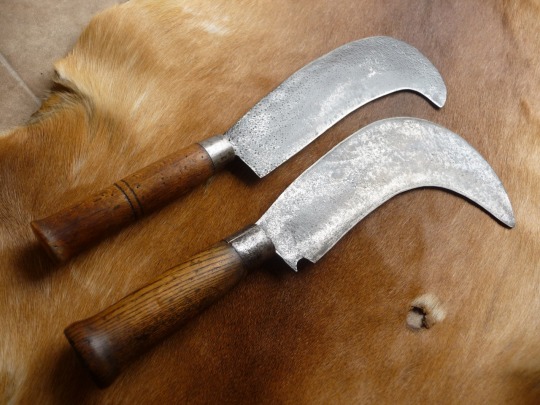
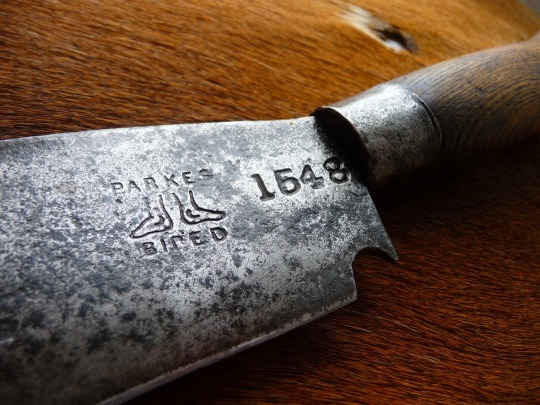
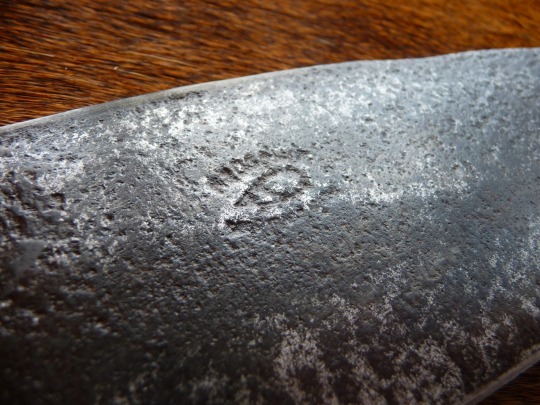
Two restored old Billhooks , all rust removed ,handles repaired ,blades are free from dinks with good working edges.
The less curved Hedgehog brand one has already sold ,only the Parkes Biped is available but only to over 18′s ,please contact for specs at the email below.
Custom knives , sheaths and gear from [email protected]
#oldtools#rustytools#parkesbiped#hedgehogbrand#billhooks#hedgelaying#hedgingtools#bushcraft#bushcraftknife#restoredtools#recycledtools#recycle#oldsteel#cuttingtool#forestrytool#madetoworkagain#curvedblade#camptool#bushknife#rtknives#rutitleyknives
16 notes
·
View notes
Text
The entire village crying and weeping gathering around the local autistic who's wearing her handmade Xena: Warrior Princess cosplay "Oh, now you want to hear me infodump about hedgelaying"
I have an entire book on food gardening in below freezing times with no electricity (all about holes and layers and growing the right varieties) written by one guy.
And it always makes me think about how if a popculture type apocalypse happens all these doomsday preppers will have to bow to one type of guy: Nerds with an hyper fixation on having fresh lettuce in januari and the ren fair guy who knows medieval doweling joints
160 notes
·
View notes
Text
Why Hedgelaying Makes a Better Hedge
Why Hedgelaying Makes a Better Hedge

Hedgelaying now seems hopelessly quaint. It’s incredible to think that there would have been thousands of agricultural workers spending months and months painstakingly managing hedges with slashers and axes. The time it took is mind boggling. This sweet video from 1942 would have been completely unremarkable – I guess the landgirl would have seemed the most unusual thing about it!
Each area had…
View On WordPress
1 note
·
View note
Text

A wee bit more progress on the hedge
1 note
·
View note
